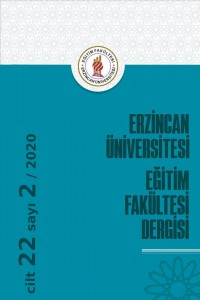Abstract
E-kitaplar alternatif sunum yapıları, öğrenme
süreçlerine yönelik farklı çoklu ortam bileşenlerini barındırmaları ve
öğrenci-içerik iletişimini üst düzeye taşımaları ile uzaktan öğretim faaliyetlerinde
sıklıkla kullanılmaya başlayan öğretim materyallerindendir. Bu çalışmanın
amacı, açıköğretim öğrencilerinin, e-kitap kullanım sıklığı, amacı, e-kitapları
faydalı bulma durumlarının ve e-kitap kullanımlarına yönelik tutumlarının
incelenmesidir. Bu çalışma kapsamında tarama yöntemi uygulanmıştır. Çalışmanın
örneklemini Atatürk Ünivertsitesi Açıköğretim Fakültesine kayıtlı 453 öğrenci
oluşturmaktadır. Veri toplama aracı iki bölümden oluşmaktadır. Birinci
bölümünde e-kitap kullanım sıklığını, amacını ve faydalı olma durumunu
belirleyen maddeler, ikinci bölümünde ise “E-Kitap Okumaya Yönelik Tutum
Ölçeği” maddeleri bulunmaktadır. Verilerin analizinde betimsel ve kestirimsel
istatistiki yöntemler uygulanmıştır. Elde edilen bulgulara göre açıköğretim
öğrencilerinin e-kitap kullanım sıklığının en fazla günlük düzeyde olduğu
görülmüştür. Açıköğretim öğrencileri e-kitapları daha çok ders çalışma ve
öğrenme amacıyla kullandıkları tespit edilmiştir. Öğrenciler e-kitapların
kitaplara göre daha kolay güncellenebilir olduğunu, erişilebilir olduğunu, her
yerde kullanılabilir olduğunu ve genel kullanımının kolay olduğunu
belirtmişlerdir. Açıköğretim öğrencilerinin çoğu e-kitapları faydalı bulmadığı
ve e-kitap kullanımına yönelik tutumlarının ise kararsız düzeyde olduğu
görülmüştür.
Keywords
References
- Bulun, M., Gülnar, B., & Güran, M.S. (2004). Eğitimde mobil teknolojiler. The Turkish Online Journal of Educational Technology, 3(2), 165-169.
- Burk, R. (2001). E-book devices and the marketplace: in search of customers. Library hi tech, 19(4), 325-331
- Çuhadar C. ve Odabaşı, F. (2004). Mobil teknolojilerin eğitimde kullanımı. Uluslararası 2. Balkan Eğitim Bilimleri Kongresi, Edirne, Türkiye.
- Davis, F.D. (1989). Perceived usefulness, perceived ease of use and user acceptance of Information Technology. MIS Quarterly, 13(3), 319-339.
- Fraenkel, J.R., & Wallen, N.E. (1990). How to design and evaluate research in education. McGraw-Hill Publishing Company.
- Güneş, F., & Susar Kırmızı, F. (2014). E-kitap okumaya yönelik tutum ölçeğinin (EKOT) geliştirilmesi: Geçerlilik ve güvenirlik çalışması. Bartın Üniversitesi Eğitim Fakültesi Dergisi 3(2), 196-212.
- Huang, Y.M., Liang, T.H, Su, Y.N., & Chen, N.S. (2012). Empowering personalized learning with an interactive e-book learning system for elementary school students. Educational Technology Research and Development, 60(4), 703-722.
- Johnson, B., & Christensen, L. (2014). Eğitim araştırmaları: nicel, nitel ve karma yaklaşımlar. Çev. Ed. SB DEMİR) Ankara: Eğiten Kitap.
- Jung, S-M. ve Lim, K-B. (2009). Leading future education: Development of digital textbooks in Korea, 12th UNESCO-APEID International Conference Quality Innovations for Teaching and Learning, Bangkok, Thailand, 24-26 March 2009.
- Kinash, S., Brand, J., Mathew, T., & Kordyban, R. (2011). Uncoupling mobility and learning: When one does not guarantee the other. In R. Kwan, C. McNaught, P. Tsang, F.L. Wang & K.C. Li (Eds.), Enhancing learning through technology: Education unplugged: Mobile technologies and web 2.0 (pp. 342-350). Berlin: Springer.
- Lai, J. Y., & Chang, C. Y. (2011). User attitudes toward dedicated e-book readers for reading: The effects of convenience, compatibility and media richness. Online Information Review, 35(4), 558-580.
- Lam, P., Lam, S-L. Lam, J., & McNaught, C. (2009). Usability and usefulness of eBooks on PPCs: How students‟ opinions vary over time. Australasian Journal of Educational Technology 25(1), 30–44. Invited republication of Lam,
- Larson, Eva Lotta Cecilia (2007). “A Case Study Exploring The “New Literacies” During a Fifth-Grade Electronic Reading Workshop”, Dissertation, Kansas State Universtiy,
- McMillan, H., & J. Schumacher, S. (2006). Research in Education Evidence-Based Inquiry. 6th Edition, Boston : Allyn and Bacon Inc.
- McKnight, Cliff and James Dearnley. 2003. Electronic book use in a public library. Journal of Librarianship and Information Science, Vol.35, no.4:235-242.
- Milli Eğitim Bakanlığı. 2011. Eğitimde FATİH Projesi. (Çevrimiçi:http://fatihprojesi.meb.gov.tr/tr/icerikincele.php?id=6), Erişim Tarihi: 23.02.2012.
- Moore, M. L. (2009). At your leisure. Assessing ebook reader functionally and interactivity. University College London
- Noorhidawati, A., & Gibb, F. (2008). Students’ attitudes towards e-books in a Scottish higher education institute: Part 1. Library Review, 57(8), 593-605
- O’Toole, J.M. ve Absalom, D.J. (2003). The impact of blended learning on student outcomes: Is there room on the horse for two? Journal of Educational Media, 28, 2-3, 179-190.
- Pattuelli, M.C., Rabina, D.(2010). Forms, effects, function: LIS students' attitudes towards portable e‐book readers. Aslib Proceedings, 62(3), 228-244, https://doi.org/10.1108/00012531011046880
- Rao, S.S. (2004), “Electronic book technologies: an overview of the present situation”, Library Review, Vol. 53 No. 7, pp. 363-71.
- Sharples, M., Corlett, D., & Westmancott, O. (2002) The design and implementation of a mobile learning resource. Personal and Ubiquitous Computing, 6, pp. 220-234.
- Shelburne, W. A. (2009). E-book usage in an academic library: User attitudes and behaviors. Library Collections, Acquisitions, and Technical Services, 33(2-3), 59-72
- Shiratuddin, N., Landoni, M., Gibb, F., & Hassan, S. (2004). E-book technology and its potential applications in distance education. Journal of Digital information, 3(4).
- Stone, N. (2008), “The e-reader industry: replacing the book or enhancing the reader experience?”, http://jps.library.utoronto.ca/index.php/fdt/article/viewArticle/4912/1778
- Vassiliou, M. and Rowley, J. (2008), “Progressing the definition of „E-book‟”, Library Hi TechVidana, Monica. 2003. E-books in public libraries. Libraries and Information Update. Available at http://www.cilip.org.uk/update/issues/mayo3/article4may.html.
- Yıldırım, G., Karaman, S. Çelik, E. ve Esgice, M. (2011). “E-Kitap Okuyucuların Kullanım Deneyimlerine Yönelik Alanyazın İncelemesi”, 5th International Computer & Instructional Technologies Symposium, 22- 24 September 2011, Fırat University, Elazığ- TURKEY.
Details
| Primary Language | Turkish |
|---|---|
| Journal Section | Articles |
| Authors | |
| Publication Date | August 31, 2020 |
| Acceptance Date | November 8, 2019 |
| Published in Issue | Year 2020 Volume: 22 Issue: 2 |

